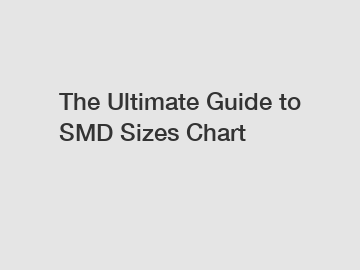The Ultimate Guide to SMD Sizes Chart
The Ultimate Guide to SMD Sizes Chart: Are You Familiar With the Different Sizes?
When it comes to surface mount devices (SMDs), understanding the various sizes is crucial. Are you familiar with the SMD sizes chart? In this comprehensive guide, we will delve into the world of SMD sizes to help you gain a better understanding. So, let's get started.
1. What are SMDs?

Surface mount devices, or SMDs, are electronic components mounted directly onto the surface of a printed circuit board (PCB). These components have become increasingly popular due to their compact size, efficiency, and ease of manufacturing.
2. Why is knowing SMD sizes important?
Knowing the different SMD sizes is important for a variety of reasons. Firstly, it allows engineers and technicians to select the right components for their specific applications. Different sizes may have varying power ratings, current capacities, or physical dimensions, which can greatly impact the performance of the circuit.
3. SMD size codes.
SMD components are typically labeled with a standardized size code. These codes consist of two digits, which represent the length and width of the component in millimeters. For instance, a standard 0805 resistor measures 0.08 inches by 0.05 inches.
4. Common SMD sizes.
There is a wide range of SMD sizes available, but let's focus on some of the most common ones:
- 0402: This is one of the smallest SMD sizes and measures 0.04 x 0.02 inches. They are ideal for compact and space-constrained designs.
- 0603: Slightly larger than 0402, 0603 SMDs measure 0.06 x 0.03 inches. They are widely used in consumer electronics and offer a good balance of size and ease of handling.
- 0805: As mentioned earlier, this size measures 0.08 x 0.05 inches. 0805 components are commonly used in various applications, including lighting, automobiles, and telecommunications.
- 1206: This size offers improved power handling capabilities and measures 0.12 x 0.06 inches. It is often used in power systems and industrial applications.
- 2512: Considerably larger than the previous sizes, 2512 SMDs measure 0.25 x 0.12 inches. They are commonly used for high-power applications due to their ability to handle more current.
5. Factors to consider when selecting SMD sizes.
When choosing an SMD size for your design, several factors should be considered:
- Circuit board space: If you have limited space on your PCB, opting for smaller SMD sizes like 0402 or 0603 can be beneficial.
- Power requirements: High-power applications typically require larger SMD sizes, such as 1206 or 2512, to handle the higher current.
- Manufacturing capabilities: Smaller SMD sizes are generally harder to handle during assembly, so it's crucial to consider the manufacturing capabilities of your chosen assembly house.
- Ease of troubleshooting: Larger SMD sizes are easier to inspect and troubleshoot, as their physical dimensions are more visible.
6. Advancements in miniaturization.
As technology continues to evolve, manufacturers are consistently striving to create even smaller SMD sizes. Miniaturization is a growing trend in the electronics industry, driven by the need for smaller, more portable devices.
7. Conclusion.
In conclusion, understanding the different sizes in the SMD sizes chart is essential for anyone working in the electronics field. By knowing the various options available and considering the specific requirements of your design, you can ensure the optimal performance and reliability of your circuits. So, are you familiar with the ultimate guide to SMD sizes chart? Take a closer look and dive into the fascinating world of SMDs.
Are you interested in learning more about Smt in Manufacturing, Surface Mount Smt, Tht and Smt? Contact us today to secure an expert consultation!


